The Very Real and Ever-Widening Gap in Skilled Talent
authors are vetted experts in their fields and write on topics in which they are extremely knowledgeable. All of our content is peer reviewed and validated by world-class professionals.

- The tight labor market is highlighting the ever-widening gap between new and outdated skills.
- Since the end of the financial crash, unemployment rates have been steadily declining, and the US is experiencing an unprecedented labor gap.
- Just “hoping” to hire new local talent when a new needed skill is identified is not going to be a viable strategy for enterprises, as there simply won’t be enough of it available for most.
- Visit Staffing.com's homepage for more.
There has been a lot of discussion in US media and policy spheres about the so-called “skills gap”: Namely, the idea that the reason why the unemployment rate was not declining -- even though the economy was growing -- was not due to weaknesses in job creation. Rather, it was because of a mismatch in the skills required to succeed in the labor market and the job the workforce actually offers. This was the idea behind the economic initiative that the US government introduced as a follow-up to the speech quoted below. This initiative focused very heavily on helping young people to find their career path and a first job, on improved data collection in order to build more insightful statistics, and finally, on training and development for in-demand jobs.
Today, technology doesn’t just replace jobs on the assembly line, but any job where work can be automated… We agree that real opportunity requires every American to get the education and training they need to land a good-paying job... Americans understand that at some point in their careers, they may have to retool and retrain. But they shouldn’t lose what they’ve already worked so hard to build.
– President Obama, 2016 State of The Union
In this article, we analyze the evolution of the skills gap over the last 10 years and the current situation in the United States and globally, and we also look at what employers can do to both understand and bridge the skills gap in their staff.
Is the Skill Gap Real and Measurable?
Quite a few studies were carried out in order to verify whether the skills gap existed and to quantify its extent. Most studies identified four areas in which the skills gap was tangible and measurable, namely, the tech sector, skilled trade workers, and workers in business and finance. A few other interesting trends can be inferred by looking at the data:
- Can’t find what we’re looking for. Despite the higher number of job seekers in the periods analyzed, many HR managers reported struggling to fill open positions. In 2018, for instance, 46% of hiring managers in the US reported problems in filling roles. When looking at the reasons for this difficulty, it becomes apparent that a lack of required skills (both soft and hard) is a big component, together with a lack of applicants and insufficient pay.
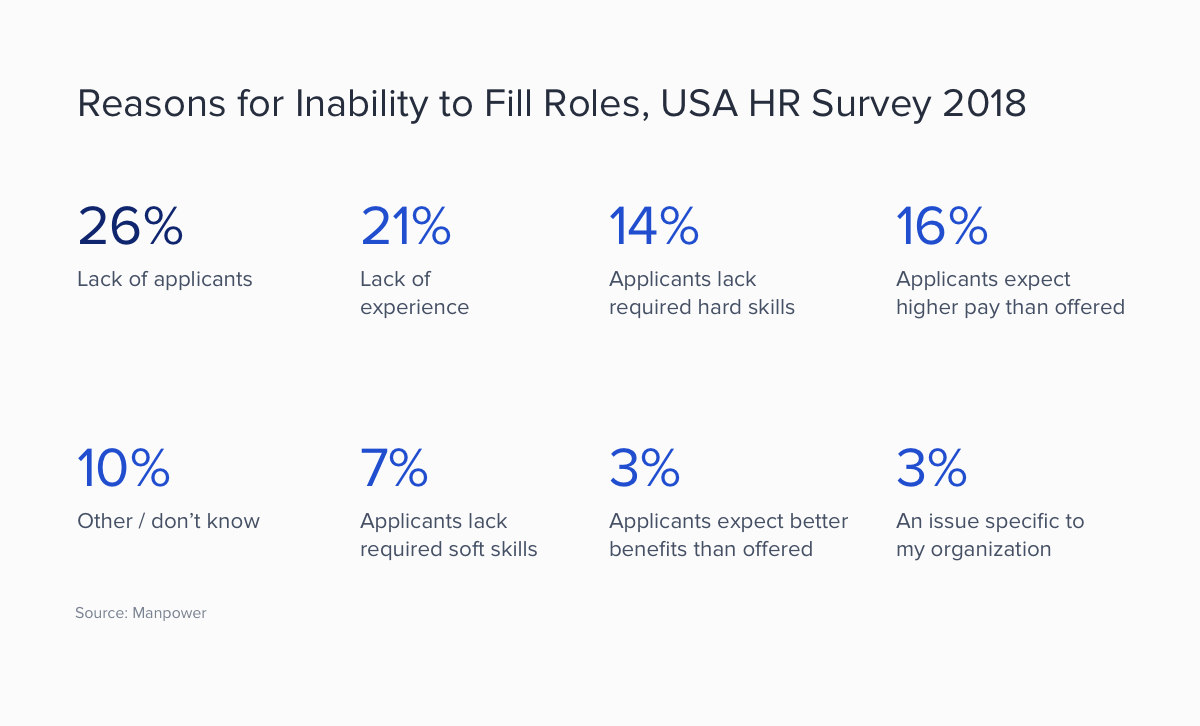
- Country vs. city. The shortfall of qualified workers is not geographically homogeneous. There are great differences between cities that are tied to educational opportunities and regional economic dynamics.

- Aging out. The aging of the workforce is a big factor in that it has contributed to and, most importantly, will continue to contribute to the shortage in the required skills in workers, as the age of the worker in some industries, particularly healthcare and skilled trades, is increasing and close to retirement age.
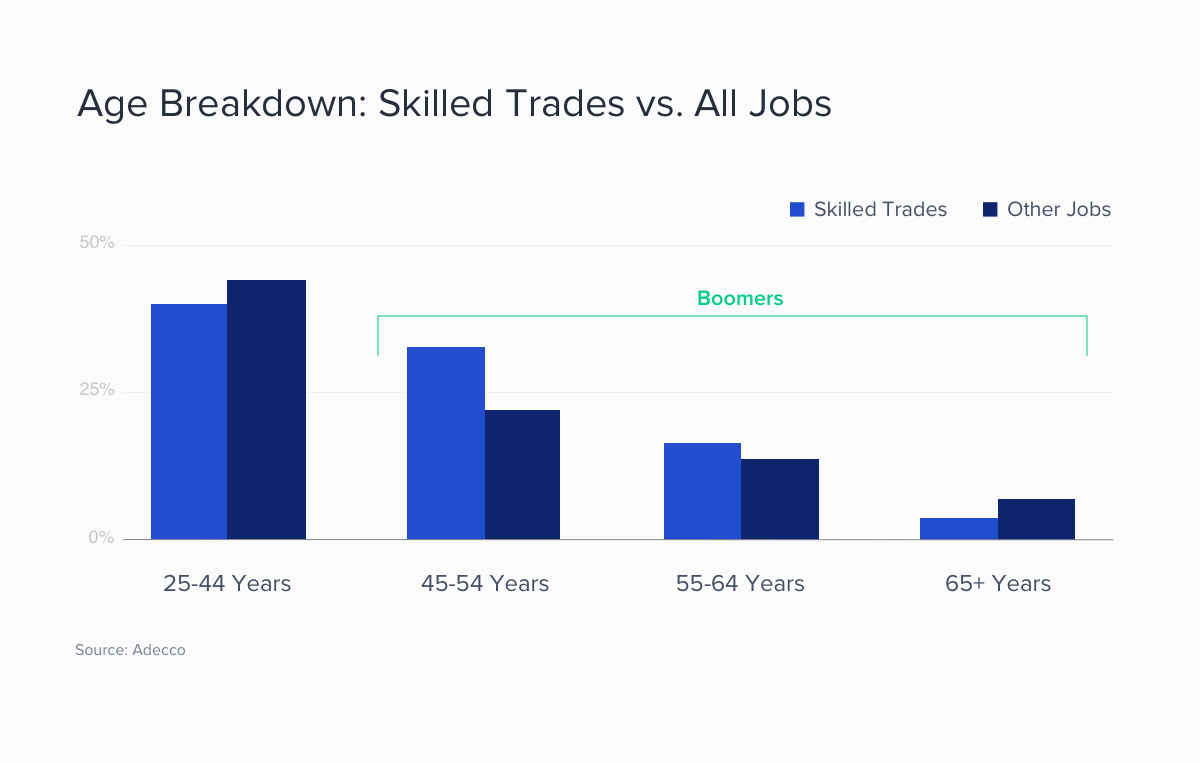
- Languishing pay. Wage stagnation is a real concern. Several economists have pointed out that real wages have seen only limited growth in the past 40 years. “Companies looking to attract enough blue-collar workers will have to continue increasing wages and, as a result, possibly experience diminished profits,” according to Gad Levanon, chief economist for North America at The Conference Board.
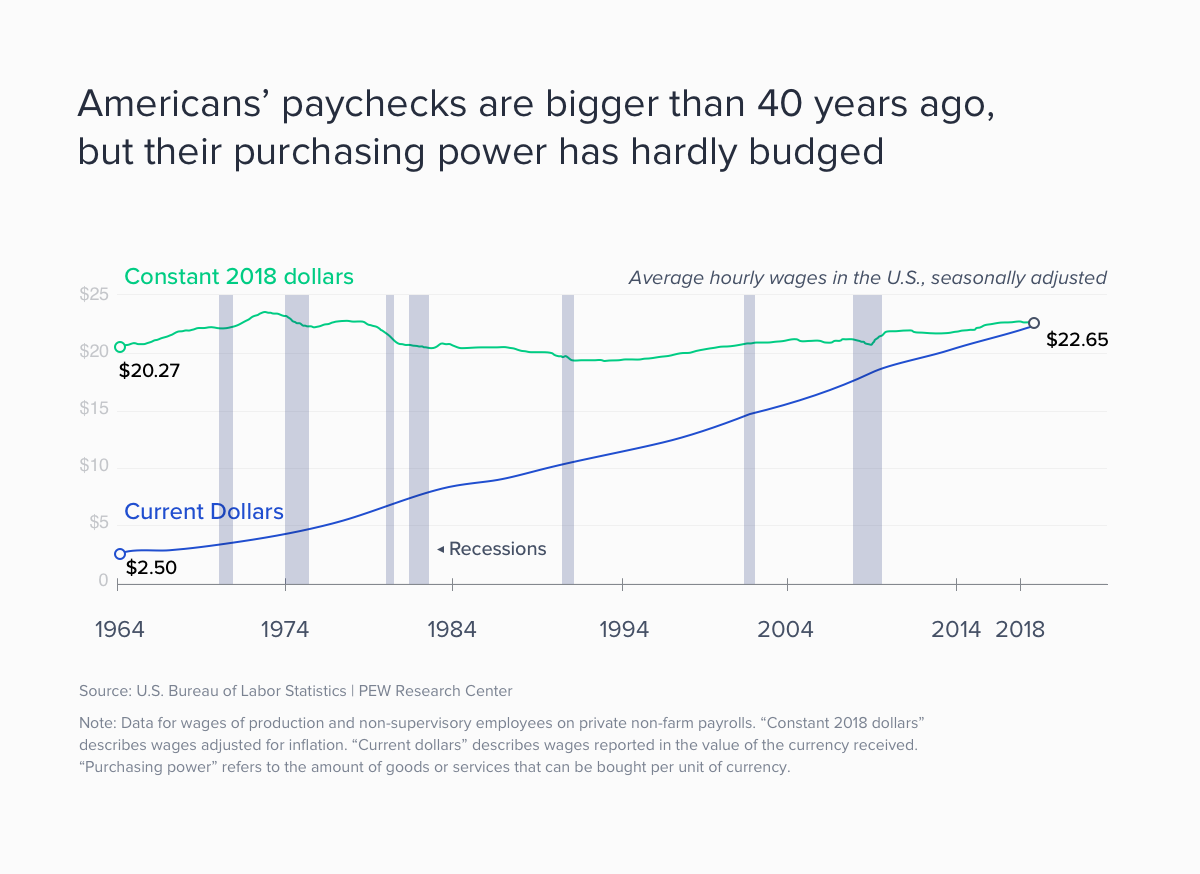
Current Situation: Skills Gap in 2019
So where does this leave us now? The state of the labor market in the US has changed substantially since the end of the financial crash and the subsequent crisis. Unemployment rates have been steadily declining, and the US is experiencing an unprecedented labor gap. In fact, since 2017, the number of people looking for a job has been lower than the number of job openings. This is the first time such a phenomenon has been observed since the Department of Labor started measuring job turnover. Does this mean that the skills gap no longer exists?
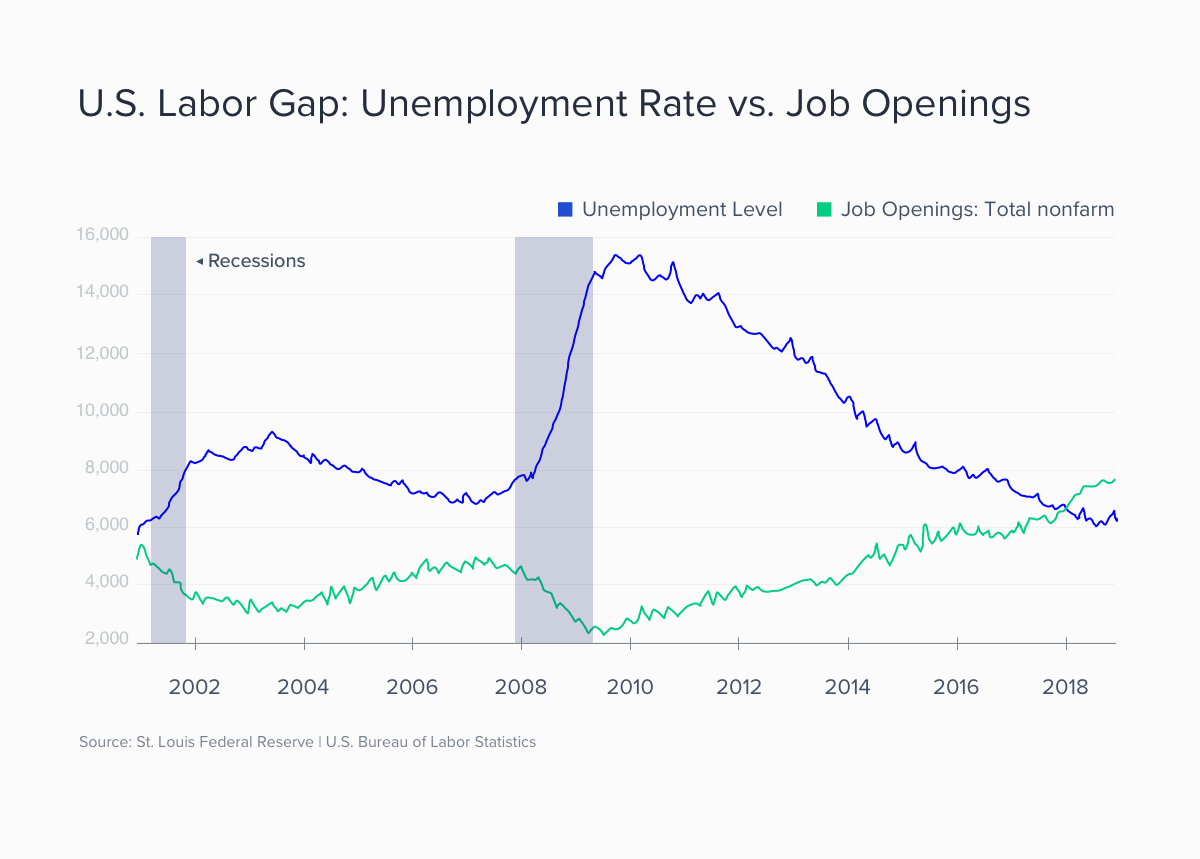
The policy narrative was that the high unemployment rate was caused not by the lack of available jobs, but by the lack of skilled workers that could fill those jobs. Intuitively then, if one accepts the validity of the link between the skills gap and the unemployment rate, the current labor gap (fewer people seeking jobs than jobs available) should be somewhat reconciled in the data through a sharp increase in skills in job seekers. But is this true?
According to a 2019 survey of 600 human resources leaders carried out by Wiley Education Services Future Workplace, not only are organizations still experiencing recruiting challenges directly connected to the skills gap, they are also finding that the skills gap in their organizations has increased over the course of the last year.
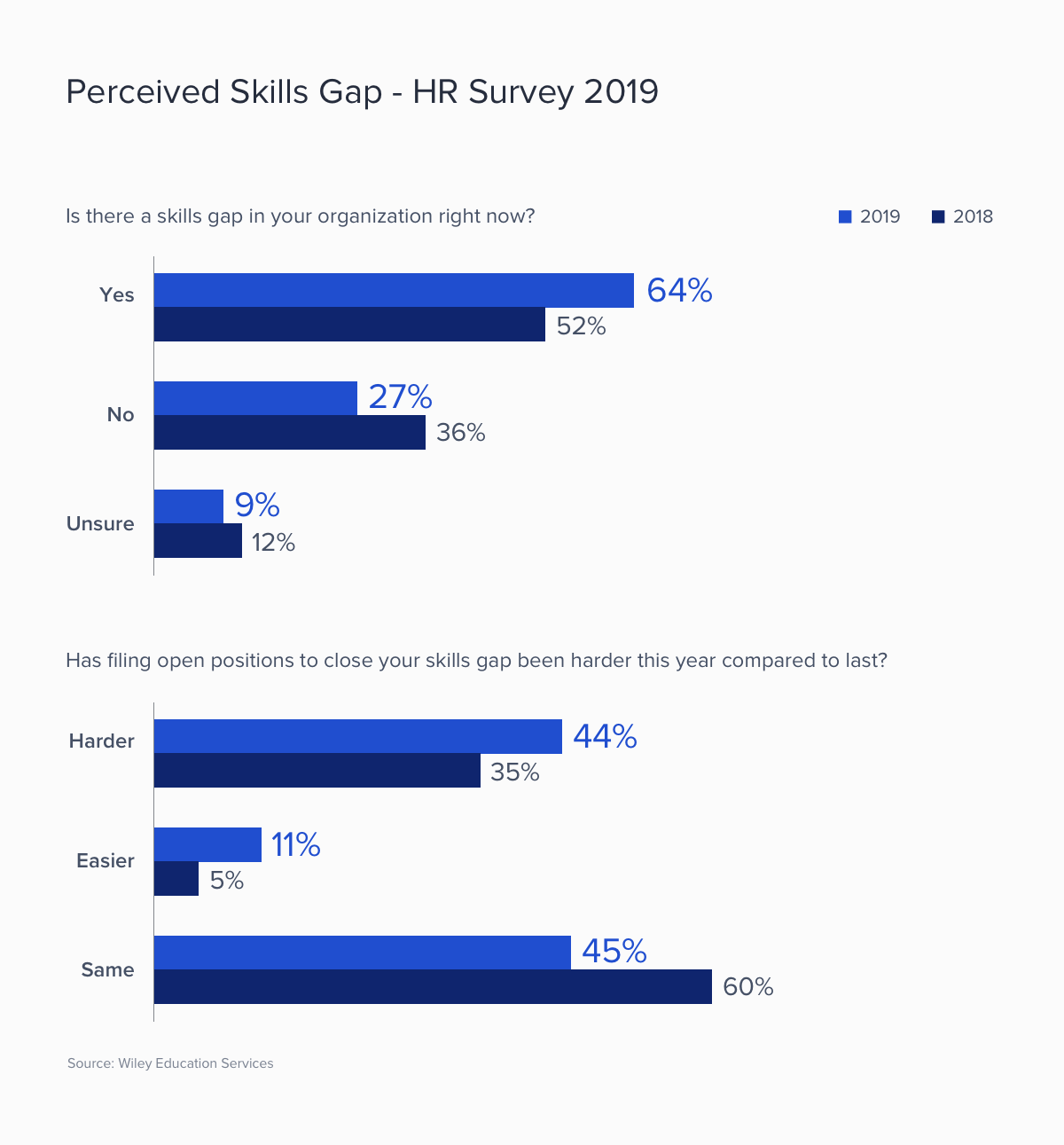
So how can one make sense of this apparent contradiction?
Two key factors emerge from the research:
- An emerging shortage of workers in blue-collar roles, caused by the continuing retirement of baby boomers and the relatively low economic participation rate (the percentage of adults of working age who are either in employment or actively seeking). This shortage has been in part compensated for by the record wage increases. Interestingly, however, a substantial number of employers had hired a person that was retired or otherwise outside the workforce.
- A somewhat distorted picture painted by national averages: Skill levels and unemployment levels vary widely across regions, reflecting regional growth trends and educational and employment opportunities.
Global Forces Behind the Changes in Labor Landscape
What are the macroeconomic forces behind the emerging skills and labor gaps and what can be expected of their evolution?
The World Economic Forum’s Future of Jobs report cites the Fourth Industrial Revolution (or Third, depending on whom you ask) as the main driver in reshaping production models and the nature and type of jobs. In particular, they identify the following crucial factors.
- Technological advances. "Ubiquitous high-speed mobile internet, artificial intelligence, widespread adoption of big data analytics, and cloud technology,” are getting adopted at a faster and faster rate. These include robotics, even though they do admittedly believe that humanoid robots are still far in the future.
- Changing geography of production, distribution, and value chains. A substantial number of firms reported intentions to relocate their activities in the next four-year period, with 74% citing the availability of skilled local workers as a key factor. Wages were also brought up as a significant factor.
- Changes in employment type. Half of the employers that participated expected their workforce to reduce in absolute numbers, but at the same time they expected to utilize more flexible contractual agreements and contractors, including on-demand talent, for specialized tasks.
- Increased automation. The increased automation of tasks such as communicating, managing, and decision making is expected to redistribute efforts on existing tasks between humans and machines.
The report also draws three conclusions that are very relevant for executives:
- A positive outlook for jobs. The demand for emerging professions is set to keep growing, while the need for core jobs should remain stable. The areas identified as being emerging and in increasing demand are the ones linked to new technologies (data analysts and scientists, software and applications developers), but also to those tasks that computers and robots will not be able to carry out even with automation (sales and marketing professionals, training and development, people and culture, organizational development specialists, and innovation managers).
- Increasing skills instability. This measures the change in skills required to carry out an existing and unchanged task. According to the report, this will amount to 42% of skills between 2018 and 2022.
The report concludes having identified a clear need for reskilling, with at least 54% of the workforce needing significant training to meet the new working requirements by 2022. However, the report also states that the strategies currently envisioned seem to be lacking and unclear, creating the potential for an excessive skill obsolescence, which, together with a shortage in skilled workers, could be very detrimental to enterprises and to the economy, which could be as large as $8.452 trillion in unrealized annual revenue by 2030—equivalent to the combined GDP of Germany and Japan, according to a study.
Themes and Potential Strategies
A few themes emerge quite clearly:
- The regional nature of the talent shortage. Not all areas are equally affected, with India, for instance, poised to have a net surplus of skilled workers in 2030, which is strongly correlated with demographic and educational trends.
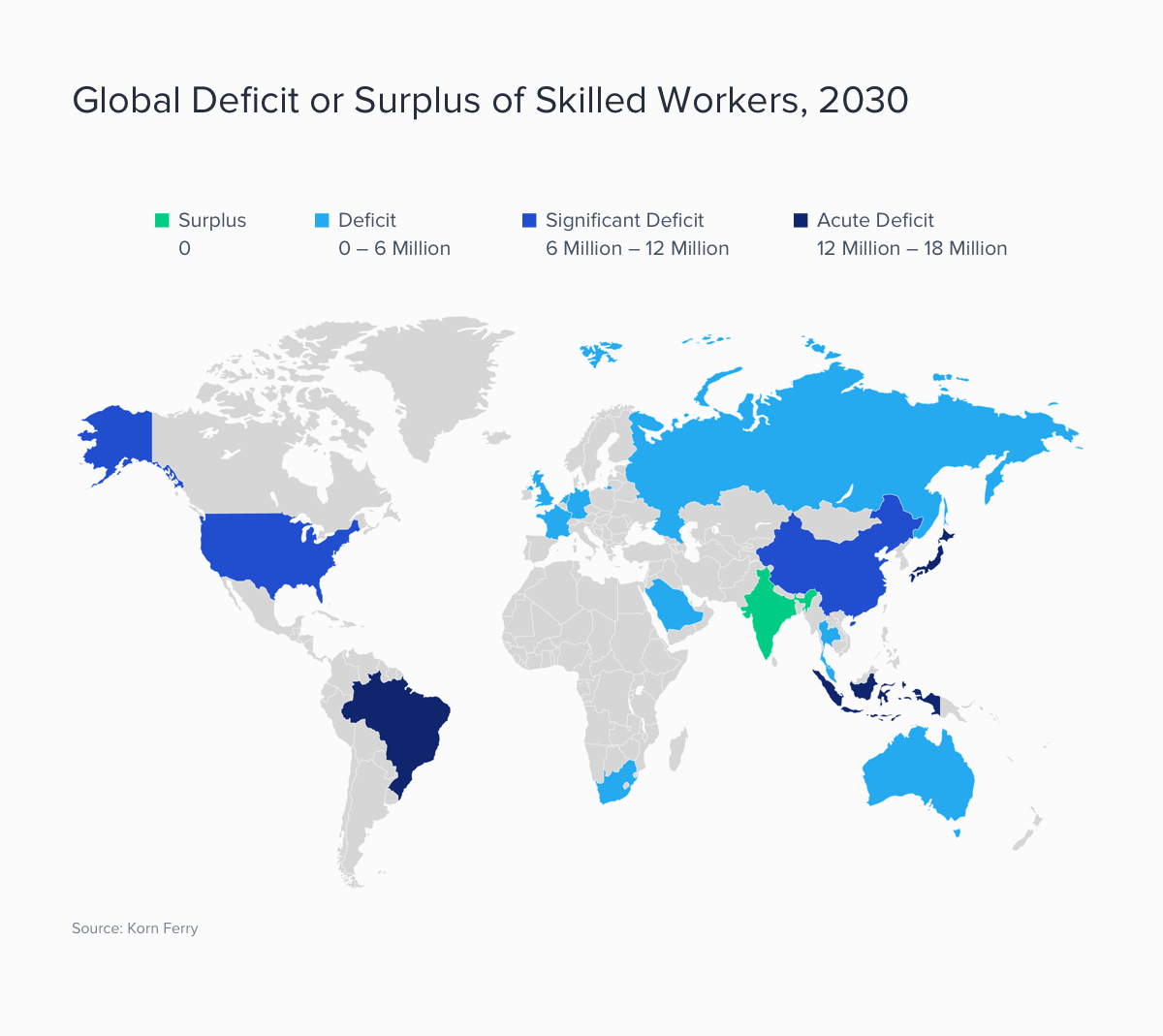
- The impact of demographic trends in developed economies. The ongoing mass retirement of baby boomers is cited as one of the top three reasons for the current shortage of skilled workers and a key determinant for the widening skills gap, particularly in manufacturing and executive roles. This negative effect is in part a consequence of poor job quality and lack of enterprise-sponsored training opportunities for those who entered the workforce amid high unemployment during and following the last recession.
- Increased wage competition for talent with the right requirements, both for tech and non-tech roles.
- An acknowledgment on the part of enterprises of their difficulties in identifying skills gaps and hiring and retaining competent staff, which is coupled with a weakness in their re- and up-skilling strategies.
It is clear from the data that just hoping to hire new local talent when a new needed skill is identified is not going to be a viable strategy for enterprises, as there simply won’t be enough of it available for most.
So what are some possible avenues for enterprise leaders, besides automating tasks and investing in technology? Partnering with local education providers to both train young people about to enter the workforce and retrain current employees and new employees that could acquire the necessary skills is an immediate opportunity, albeit one that is not simple to implement and will take time to bear fruits. Another strategy that some forward-looking managers are adopting is that of integrating on-demand and remote talent into their workforce. It will be imperative for the survival and viability of many companies to be proactive in their approach to their future enterprise needs, lest they obsolesce together with the skills of their employees.
